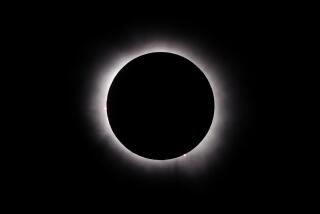1,000 Get the Star Treatment During Astronomy Event
- Share via
SIMI VALLEY — Ventura County astronomy buffs have had more than a few reasons to look up lately. And on Saturday, they shared their fascination with hundreds of others during a celebration marking National Astronomy Day.
More than 1,000 devoted and would-be stargazers participated in the event organized by the Ventura County Astronomical Society. Held in the parking lot of the Sycamore Plaza in Simi Valley, the celebration brought scores of astronomers, from the professional to the backyard amateur, who enthusiastically shared their knowledge and fascination with those who weren’t as familiar with the wonders of the firmament.
For the record:
12:00 a.m. April 17, 1997 For the Record
Los Angeles Times Thursday April 17, 1997 Ventura County Edition Metro Part B Page 5 Zones Desk 2 inches; 39 words Type of Material: Correction
Telescope filters--An article Sunday on how the Hale-Bopp comet has stirred interest among local astronomers did not include a warning about the dangers of looking at the sun directly. When viewing the sun through a telescope, safety filters to protect the eye are necessary.
“There’s something here for everybody,” said society member Jim Cassou. “I hope we can get somebody interested in astronomy because it really is a fascinating subject.”
Of all the exhibits at the celebration, none was as popular as the one devoted to comet Hale-Bopp. The display featured information on where comets originate, what they are made of and photographs taken by society members of the comet streaking through the heavens.
“A comet as spectacular as Hale-Bopp doesn’t come around too often,” Cassou said. “And I think that’s really helped make astronomy popular again.”
This was the ninth year the society has organized an astronomy day celebration. Last year, Sky and Telescope Magazine honored the society for its festivities.
After the celebration, the astronomical society threw a “star party” at the Moorpark College Observatory, where about 400 participants could get close-up views of the Earth’s celestial neighbors.
Through the college’s powerful telescope, the stargazers peered at the craggy, pock-mocked surface of the moon and the tiny jets of steam and hot gas shooting out of Hale-Bopp.
The daylight portion of the celebration also featured activities that piqued the interest of young and old, including exhibits on how to build telescopes, information on black holes and a comet-building demonstration.
Several times throughout the day, event organizer Tim Robertson thrilled the crowd by mixing blocks of dry ice, dirt, water and ammonia to make a comet.
“This is what the Hale-Bopp comet would look like if you could see it up close,” Robertson told the crowd as he handed out comet samples. “It’s really just a dirty snowball, that’s all.”
Others took the opportunity to peer through one of the many telescopes aimed at the sun. Through them, they could observe the tiny black sun-spots that peppered the surface of the fiery-orange ball of gas.
*
“This is a really a fun group of people, and they’ve done a great job in showing how interesting all this stuff is,” said 54-year-old Val Akins, an amateur astronomer from Laguna Niguel who drove up for the event. “There’s been so much going on up there in the sky right now, so this couldn’t have happened at a better time.”
According to Cassou, interest in astronomy has blossomed in recent weeks with the passing of comet Hale-Bopp, intense solar activity and the tantalizing possibility of life on the Jovian moon Europa.
Last week, a flare erupted from the sun and sent a shock wave barreling through the solar system at 2 million mph. Remnants of the flare, a million-mile-long ribbon of superheated gas, are still visible.
A few days later, the Galileo spacecraft sent back pictures of icy Europa that hinted that an ocean of liquid water, and the possibility of life, exists beneath the moon’s frozen surface.
“It’s definitely built an awareness and gotten people to appreciate astronomy more,” Cassou said.
Both Cassou and Robertson said one of their main goals was to get children interested in astronomy.
“The absolute best case would be to influence one of these kids to become the next Carl Sagan,” Cassou said. “They really are the future of astronomy, and we need to get them interested when they’re young.”
Judging by the barrage of questions asked by hundreds of popcorn-munching kids, they did just that.
“I’ve already read a lot of books about astronomy, but I learned a lot more stuff today,” said 11-year-old Scott McArthur of Simi Valley. “Now I want to get a telescope and look at the stars and the moon myself.”
More to Read
Sign up for Essential California
The most important California stories and recommendations in your inbox every morning.
You may occasionally receive promotional content from the Los Angeles Times.










